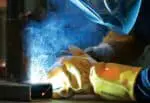Gloves are an absolute necessity for welding operations, however they are not easy to clean. Your welding gloves will last longer if you keep them in good shape, but cleaning your welding gloves necessitates a few more measures.
The first step is to identify the material of your welding gloves. All welding gloves are made to be fire-resistant, flexible, long-lasting, and waterproof for your safety.
And they’re made of two materials: leather and synthetic. The most common one, leather, is effective at dissipating heat while retaining flexibility, durability, and water resistance.
Cowhide, sheepskin, goatskin, and pigskin are the most popular leathers used for leather welding gloves. However, the cleaning method may vary depending on the type of leather.
You cannot wash your suede welding gloves the same way you wash your regular leather. The point is that you cannot wet your suede gloves, so using a suede eraser or a small amount of vinegar to clean it is the best way to go.
Suede, which is made from animal hide that has been tanned and buffed, is known for its velvety nap and soft, plush feel. This material works especially well for gloves since it is warm while being lightweight and attractive.
Suede is, however, a delicate fabric that is sensitive to dampness and prone to staining. It’s not difficult to keep them looking new, all you have to do is prepare yourself with the right tools and procedures.
Let us get started.
All you need is:
-
-
- Suede brush, or even an old soft bristle toothbrush would work
- Suede Eraser
- Paper towels
- Cornstarch
-
1st Step
To absorb moisture before it hardens into the suede, dab a dry paper towel over any water spots that bead on the surface of the suede gloves. Use a moist towel and white vinegar to remove dried-on liquid stains.
Apply a little amount of vinegar to dampen the stain and gently massage it with the cloth. You may need to do this numerous times.
2nd Step
Allow an hour to settle after generously applying cornstarch to oil-based stains on suede gloves. Shake the suede gloves to dislodge any remaining cornstarch, and then carefully remove the discoloration with an old toothbrush or suede brush.
3rd Step
Rub a brown art gum eraser across any dried-on or crusty stains on the suede gloves, such as dirt, to remove them.
4th Step
If none of the previous techniques work, take your suede gloves to a dry cleaner that specialises in leather products.
We usually do not find welding gloves made of suede leather, because of their delicate nature and hard maintenance.
Regular leather that has a smooth texture is the most preferable material for welding gloves. And there are different types of welding gloves for different purposes.
Welding gloves are made from a variety of materials. As a result, you may come across a variety of cleaning instructions. The following are the most prevalent types of welding gloves:
TIG welding glove- It is designed to safeguard your hand to the greatest extent possible. These gloves, together with the sensitivity of the right finger, undoubtedly suit the needs of many welders. They are often manufactured from the hide of a goat, pig, or cow.
MIG welding gloves- These gloves offer superb agility as well as protection. They are manufactured from the skin of a deer, a cow, or a pig.
Stick welding gloves- They are composed of the most durable materials. However, stick welding gloves made of deer or cow hides are available.
See also: Best Welding Gloves for Beginner
Tips on how to clean your leather welding glove
Read the cleaning instructions provided by the manufacturer.
Since your leather welding gloves are likely to be made keeping a few things in mind, it is always recommended that you first read the manufacturer’s guidelines on how to wash your gloves.
When it comes to cleaning the exteriors of your leather welding gloves, there are basic principles to follow, but the materials utilised for the interiors might vary.
It is also usual for reinforcing foiling to be placed between materials to strengthen the heat resistance of your leather welding gloves.
Your welding gloves should come with notes outlining any particular cleaning instructions that take into account the unique construction of your gloves.
Thoroughly cleaning on the exterior.
Before washing your leather gloves, you should thoroughly clean them, especially if they are unclean or contain visible debris such as metal, cleansers, and other substances.
Wipe your gloves down with a dry towel. Another method for harsh cleaning gloves is to use a toothbrush or a soft-bristled wire brush to remove big bits of material.
Use cold water to thoroughly rinse your gloves.
Because your gloves may collect a lot of dirt, it is recommended to begin the cleaning procedure with a thorough rinse. You may keep your gloves on throughout this process.
Scrub your gloves in the same manner you would wash your hands, using cold or room temperature water as much as possible.
Use soap to clean the exterior of your leather welding gloves.
After your initial rinse, it’s time to use soap to remove the dirt that water alone cannot remove. If at all feasible, it is recommended that you use a leather-specific soap.
Using the incorrect soap may and will strip the leather of its natural oils, resulting in an unfavourable stiffening aftereffect.
If you don’t have access to leather-specific soap, a PH neutral soap made entirely of natural components would suffice.
Apply the soap to the palms of your gloves and massage your gloved hands together to make a lather. Work the soap around the whole surface of your glove before gently rinsing it off with water.
You can go for Lexol pH-Balanced Leather Cleaner-
- Ideal for use on: leather auto upholstery, footwear, furniture, handbags & briefcases, sports equipment and luggage
- Contains no waxes, oils, or additives that interfere with its cleaning capabilities
- Rinses easily, leaving leather healthy, supple and able to breathe
- Leaves no tacky residue
- pH-balanced formula maintains the pH range of leather itself, which means it cleans leather safely as well as the stitching and other fibers that hold leather together
Prices pulled from the Amazon Product Advertising API on:
Product prices and availability are accurate as of the date/time indicated and are subject to change. Any price and availability information displayed on [relevant Amazon Site(s), as applicable] at the time of purchase will apply to the purchase of this product.
To get rid of excess water, grip your fist and extend it while wearing your gloves. Remember not to wring your gloves at any cost.
Disinfectant solution should be sprayed into the interior of leather welding gloves.
If your day’s labor has you sweating, you have to make sure to sanitise the interiors of your gloves and reduce smells. Make a 50/50 mixture of white vinegar and water.
Apply the solution using a spray bottle, taking care not to saturate the interiors of your gloves.
Check out this Microban Disinfectant Spray-
- Microban is an EPA registered disinfectant
- This multi-purpose cleaner sanitizes surfaces, disinfects bacteria & viruses, deodorizes, and prevents mold & mildew
- Effectively kills 99.9 percent of bacteria and viruses within 60 seconds on hard non-porous, non-food contact surfaces
Prices pulled from the Amazon Product Advertising API on:
Product prices and availability are accurate as of the date/time indicated and are subject to change. Any price and availability information displayed on [relevant Amazon Site(s), as applicable] at the time of purchase will apply to the purchase of this product.
Dry Your Welding Gloves Made of Leather
Now that your leather welding gloves have been thoroughly cleaned, it is time to lay them out to dry. You have to make sure that your next use of your gloves is safe.
That is, do not use artificial heat or keep your gloves out in direct sun. This might cause your gloves to shrink as well as harden the surface area of your leather gloves.
If you are washing TIG welding gloves, it is recommended that you wear them a few times throughout the drying process to verify that the glove fit is maintained.
This is also applicable to other types of welding gloves, but it is especially essential for TIG welding gloves.
Leather Welding Gloves Should Be Conditioned
If you see your welding gloves hardening up and are uncomfortable while working, conditioning them after a wash might help soften them.
Apply leather conditioner with a microfiber cloth and massage in a circular motion to achieve uniform application across all of your leather’s surface regions.
While most leather conditioners are not flammable, it is wise to double-check that your conditioner is not flammable, since you don’t want your gloves to be exposed to sparks while coated with a flammable material. In any case, make sure your welding gloves are completely dry before using them.
You can use leather conditioners by Leather Honey-
- POWERFUL LEATHER CONDITIONER
- RESTORE ALL TYPES/COLORS OF LEATHER
- FAMILY-OWNED, AMERICAN-MADE, SPECIALLY FORMULATED
- UNLIMITED 100% SATISFACTION GUARANTEE
Prices pulled from the Amazon Product Advertising API on:
Product prices and availability are accurate as of the date/time indicated and are subject to change. Any price and availability information displayed on [relevant Amazon Site(s), as applicable] at the time of purchase will apply to the purchase of this product.
To conclude, your leather glove made of suede is sure to give you protection, but it also requires a lot of care and maintenance to last you for a long time.
Because suede is so sensitive to moisture, it’s ideal to wear your suede gloves on days or nights when the weather is clear.
Never soak your suede gloves in water or wash them in the washing machine, since this will destroy them.
However, in this article, we have provided you with enough knowledge on other alternatives you can go for and how to keep your welding gloves clean.











